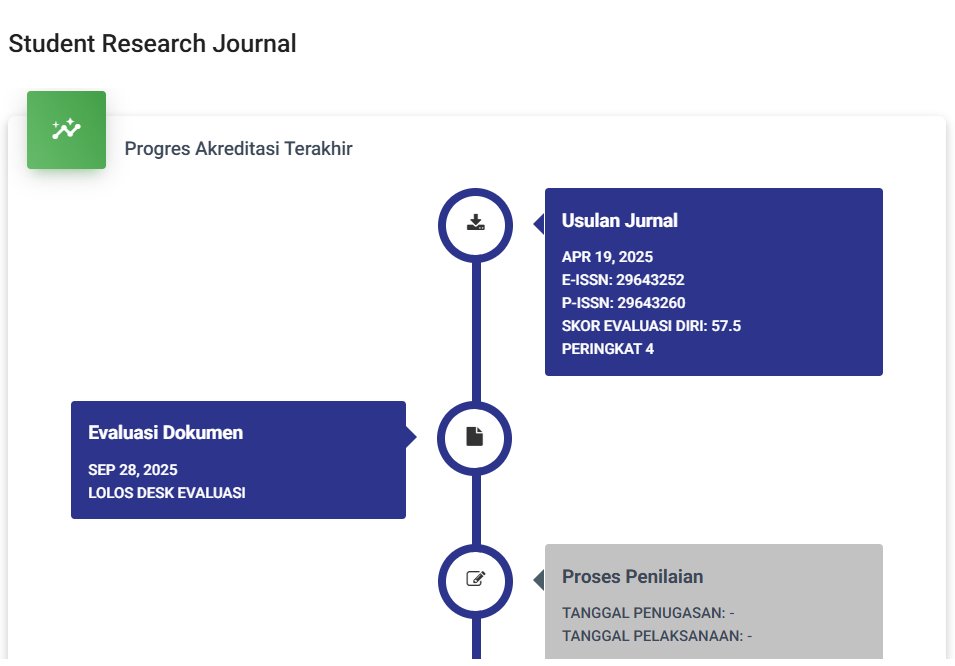Penerapan Reading Guide dalam Meningkatkan Kemampauan Pemahaman Isi Teks Wacana di Kelas IV SD Negeri 0119 Banjar Raja
DOI:
https://doi.org/10.55606/srjyappi.v1i5.687Keywords:
Reading Guide, Discourse Text ContentAbstract
The aim of this research is to determine the application of the reading guide strategy in improving students' ability to understanding the content of discourse texts in Indonesian language subjects in class IV of SD Negeri 0119 Banjar Raja. The research used is PTK research, namely classroom action research. The subject of this research is SD Negeri 0119 Banjar Raja and the object of this research is class IV with a total of 21 students. There are two data sources that researchers use, namely primary data sources and secondary data sources. . Primary data sources are data taken directly from the research object, namely class IV students and teachers. This primary data source comes from field data obtained from observations and interviews. Secondary data sources are data taken in the form of documents, such as books, books, dictionaries and other literature related to skills in understanding the content of discourse texts. There are three cycles in the design of this research cycle, namely Pre-Cycle, Cycle I and Cycle II. Based on the results of the research carried out by the author, it can be concluded that the application of the reading guide strategy in improving the ability to understand the content of discourse texts in class IV Indonesian language subjects at SD Negeri 0119 Banjar Raja, Barumun District, Padang Lawas Regency, namely in the pre-cycle only 2 students or 9.52 % who have the category "very good" 4 students or 19.05%, "good", 8 students or 38.10%, "fair", 6 students or 28.57%, "poor", 1 student or 4.76 % "very poor", while students' ability to understand the content of cycle I discourse texts has begun to increase, namely 4 students or 19.05% who have the "very good" category, 6 students or 28.57%, "good", 10 students or 47 .62%, "sufficient", 1 student or 4.76%, "poor", no students "very poor", and students' ability to understand the contents of cycle II discourse texts has increased, namely 11 students or 52.38%, which has a "very good" category, 9 students or 42.86%, in the "good" category, 1 student in the "fair" category, no students in the "Poor" category, no students in the "very poor" category. So it can be concluded that the reading guide strategy can improve the ability to understand the content of discourse texts in class IV Indonesian at SD Negeri 0119 Banjar Raja, Barumun District, Padang Lawas Regency.
References
Akib, Haedar. 2008. “Implementasi Kebijakan: Apa, Mengapa, dan Bagaimana.” Psychiatria Hungarica : A Magyar Pszichiátriai Társaság tudományos folyóirata 23(1):34–41.
Azis, Saiful. 2017. “Implementasi Kultur Literasi Dalam Meningkatkan Kemampuan Membaca Menulis dan Berpikir Kritis Siswa SD Plus AlKausar Malang.” Universitas Islam Negeri Maulana Malik Ibrahim Malang 2(1).
Ahmad fauzi, dkk. (2016). Metodologi Penelitian. CV Pena Persada.
Binti Anisaul Khasanah, I. D. A. (2017). Kemampuan Berpikir Kritis Siswa Melalui Penerapan Model Pembelajaran Brain Based Learning. Nucl. Phys., 13(1), 104–116.
Herdiana, R. (2019). Hubungan Minat Baca dan Gerakan Literasi Sekolah Terhadap Keterampilan Berpikir Kritis Siswa Kelas V SDN Gugus Dwija Harapan Kecamatan Mijen. Skripsi UNNES, 1–146.
Kemendikbud. (2015). Peraturan Menteri Pendidikan Dan Kebudayaan Republik Indonesia Nomor 23 Tahun 2015 Tentang Penumbuhan Budi Pekerti. Permendikbud, 45.
Mu’alimin, & Cahyadi, R. A. H. (2014). Penelitian Tindakan Kelas Tori dan Praktik. Ganding Pustaka. http://eprints.umsida.ac.id/4119/1/BUKU PTK PENUH.pdf
Permatasari, A. (2015). Membangun Kualitas Bangsa dengan Budaya Literasi. Seminar Nasional Bulan Bahasa UNIB, 146–156.
Rohim, cahya dhina, & Rahmawati, S. (2020). Di Sekolah Dasar Negeri. Kajian Pendidikan Dan Hasil Penelitian, 6(3), 2.
Downloads
Published
How to Cite
Issue
Section
License
Copyright (c) 2023 Rasmi Hutasuhut, Nurhayati Siregar, Irma Sari Daulay

This work is licensed under a Creative Commons Attribution-ShareAlike 4.0 International License.








